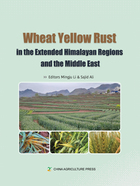
1.6 Quantitative Trait Ioci (QTL) and Genome-wide Association Study (GWAS) of Yellow Rust Resistance Genes
More than 140 QTLs for yellow rust resistance in wheat and 47 chromosomal regions were identified worldwide (Rosewarne et al., 2013). Many of the regions contain more than one gene, for example, chromosome 2B has a region that contains a number of major genes such as Yr27, Yr31 and Yr7, as well as a number of QTLs that are effective at adult plant stage. The strongest effect QTLs are generally associated with major genes such as Yr17. Many of these QTLs are identical genes. Lots of work have been carried out in China to identify QTL of yellow rust resistance, using Chinese wheat landraces and commercial cultivars which exhibited APR to yellow rust over many years.
Several Chinese wheat landraces such as Humai 15, ‘Guangtoumai’, Pingyuan 50, and Qing Shumai, have been studied for their QTLs. In Humai 15, a major effect QTL was identified and was located on the centromere of chromosome 2B, accounted for 47.2% of the phenotypic variation (Yuan et al., 2018). In Pingyuan 50, three QTLs on chromosomes 2BS, 5AL, and 6BS, explaining 4.5%~19.9% of the phenotypic variation respectively, were designated as QYr.caas-2BS, QYr.caas-5AL, and QYr.caas-6BS (Lan et al., 2010). In ‘Guangtoumai’, a major locus named QYr.GTM-5DL located on chromosome 5DL, explained up to 44.4% of the total phenotypic variation, and was present in 5.3% of the 247 surveyed Chinese wheat landraces (Wu et al., 2021). In Qing Shumai, a major QTL on chromosome 6D was designated as QYr.cau-6DL, with which a SSR marker (gpw5179) was tightly linked (Zhang et al., 2017).
Commercial wheat cultivars such as Bainong 64, Chuanmai 42, Chuanmai 55, Xinong1376, Qinnong 142, and Shannong 33 also have been studied. Five loci were detected from Bainong 64, and were located at the same positions as the Yr29/Lr46 and Yr46/Lr67 genes, respectively (Ren et al., 2012). Locus Qyr.saas-7B from Chuanmai 42, and Qyr.saas-1B and Qyr.saas-2A from Chuanmai 55 was identified. The Qyr.saas-1B explained 6.24%~34.22% of the phenotypic variation, overlapped with Yr29, whereas a significant additive effect was observed when all three QTLs were combined (Yang et al., 2019). Six QTL from Xinong 1376 identified, QYr.nwafu-4AL and QYr.nwafu-6BL.3 conferred stable resistance in all environments (Mu et al., 2019a). Four QTLs in Qinnong 142 on chromosome arms 1BL, 2AL, 2BL, and 6BS were characterized (Zeng et al., 2019). Four consistent QTL were detected on 1BL, 2AS, 3DL, and 6BS in Shannong 33. The 2AS locus was identified as Yr17. The QTL identified on 1BL and 6BS likely correspond to Yr29 and Yr78, respectively. A QTL on 3DL explaining 5.8%~12.2% of the phenotypic variation is likely to be new (Huang et al., 2020). Several other studies have been done to identify QTLs in diverse wheat (Lu et al., 2009; Wu et al., 2017; Wu et al., 2018; Yao et al., 2019; Mu et al., 2019b; Ye et al., 2019; Cheng et al., 2020).
All these QTL loci and their closely linked molecular markers will facilitate marker-assisted selection, gene pyramiding, and improve the level of APR against yellow rust in breeding programs.